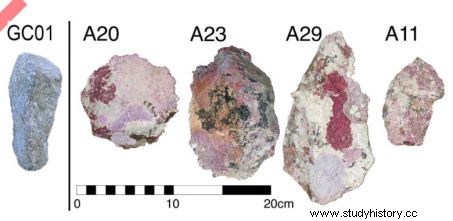Archaeologists have located in Australia two aboriginal sites at least 7,000 years old, the first under the sea ever discovered in the country. It is estimated today that the ancient Aborigines arrived on the island-continent nearly 65,000 years ago. These sites could be among their oldest centers of settlement.

In the Cap Bruguieres channel, divers have identified 269 artifacts dating back at least 7,000 years. These are the first confirmed underwater archaeological sites discovered on the island-continent.
When the first humans arrived in Australia at least 65,000 years ago, sea levels were 80 meters lower than today. Australia, then connected with New Guinea, was, as today, mainly populated on its coasts, where the resources of the sea like those of the forest were easily accessible. At the end of the last ice age around 10 to 20,000 years ago, with the melting of the glaciers, nearly 30% of the entire island-continent was swallowed up on its periphery. With them, the traces of these first camps, never located so far.
In an article published July 1, 2020 in the journal PLOS ONE , a team of international archaeologists reports having finally identified in the country, 160 meters offshore and 2.5 meters deep, the first two underwater prehistoric sites in Australia. Located in the Dampier archipelago, a group of islands located off the city of Dampier, in the west of the country, they have been frozen in these shallow seabed for at least 7,000 years. "Maybe much more" for Jonathan Benjamin, one of the archaeologists behind their discovery and first author of the study published today.
Knives and axes
Nearly 300 stone artifacts still intact have been listed there by archaeologist divers. Among them, knives, axes or even mortars, ancestral witnesses of human activity associated with the production of food. "We were surprised to find that most of these objects were still very sharp, when we thought the sea would have done its job. Even with the tides, they did not move, they remained in a stable chain lying on the bottom of the water" , is still surprised Jonathan Benjamin.
But if these tools were quietly sleeping on the sand a few tens of meters from the coast, why not have found them earlier? "For a sports diver who is not familiar with this kind of ancient artifacts, it is difficult to differentiate them from simple pebbles. As for underwater archaeologists, they simply have a different reading grid from the discipline in Australia" , explains the specialist.
A complex dating
Because if underwater archeology has been practiced in the country since the 1960s, it has so far only consisted of locating the wrecks of colonial ships from the 17th and 18th centuries. Never prehistoric sites, or rather, ancient aborigines. "Let's not forget, the indigenous Australians arrived before the first sapiens in Europe." These underwater excavations are also the Aborigines of today who have claimed them. Today, the fifty or so upwelling tools are in their hands and have been added to their cultural heritage.

A20, A23, A29 and A11 do not show, unlike GC01, signs of "rolling", in other words erosion. They remain sharp, and therefore identifiable as man-made tools. Credits:Jonathan Benjamin/University of Flinders/PLOS ONE
Unfortunately, it is extremely difficult to date these two sites with precision. To determine their minimum age – from 6,000 to 7,000 years therefore – the researchers relied on dating from other nearby terrestrial sites and on that, carried out with carbon 14, of mollusc shells found alongside the artifacts. "In addition to these data, we have estimated with geologists that the beach now under water (the one populated by these ancient men) was formed around 125,000 years ago." In fact, between 6,000 and 125,000 is a wide range... "These individuals could very well have carved these stones 60,000 years ago" , supposes Jonathan Benjamin.
"An immense field of possibilities"
This discovery, Jonathan Benjamin sees it as an open door to the future of underwater archeology:"Not only do we have proof that based on the cartography of before the end of the ice age , when the sea level was not so high, we can locate these hearths, but we realize here that the sea does not damage these sites in any way, as we have always believed, but rather puts them under glass. ."
Now, the scientist would like to be able to apply his methods on the North Coast, where the continent was previously connected with Tasmania, but also elsewhere in South Asia. "You have to keep in mind that the first human populations were on the coasts. It is therefore an immense field of possibilities that opens up to underwater archeology now that we have understood how to proceed. "
Australian law would still have to change, if we want to hope one day to preserve this still unknown heritage:since 2018, the State has only protected underwater sites... presenting a wreck more than 75 years old. The ancient underwater Aboriginal sites may be 60,000 years old, but they will not always benefit from this protection.
